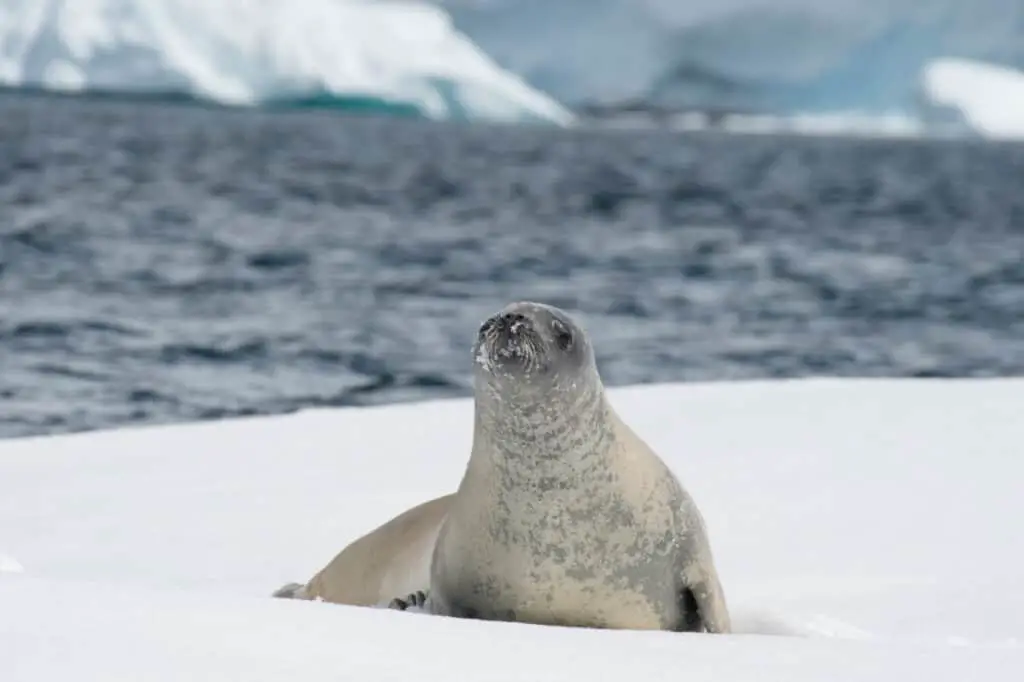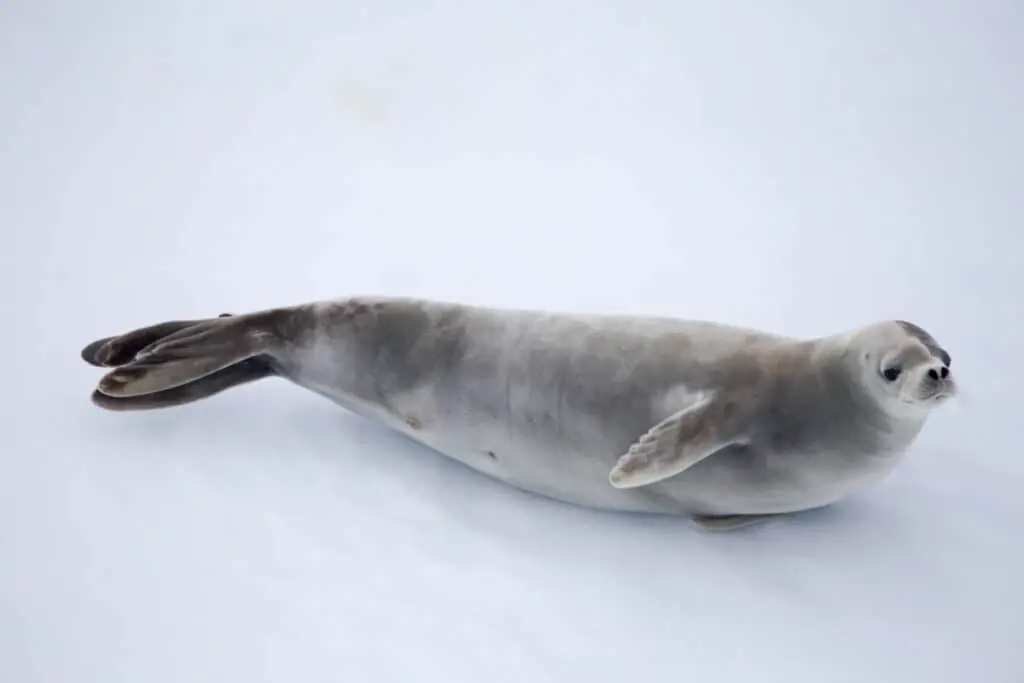The Crabeater seal, or Lobodon carcinophaga, is one of the most abundant seals in the world and can be found throughout much of the Antarctic region.
Despite their name, these seals do not primarily feed on crabs but instead consume krill, a tiny shrimp-like crustacean that lives in large swarms in Antarctica’s icy waters. These creatures are an important food source for many marine animals in this region, including whales and penguins.
Crabeater seals have several unique adaptations that allow them to thrive in the harsh Antarctic environment. They possess long whiskers that help them detect prey in murky water and sharp teeth that enable them to filter out krill from seawater efficiently. Additionally, they have thick fur coats that provide insulation against freezing temperatures and blubber layers that store energy reserves during lean times.
In this article, we will explore further the biology, behavior, conservation status of Crabeater seals as well as the ecological role they play in Antarctic ecosystems.

Habitat And Distribution
The crabeater seal (Lobodon carcinophagus) is a species of seal that can be found in the Southern Ocean, particularly around Antarctica. They have one of the largest geographical ranges among seals, as they are known to inhabit areas from 60°W to 130°E and from 70–75°S to the Antarctic continent.
Crabeater seals prefer ice-free waters near pack ice or fast ice where their prey, krill, thrives. They are well adapted to living in cold environments with temperatures ranging from -15°C to +5°C. They are typically found in regions where sea surface temperature varies between -1.8°C and +2.0°C throughout the year.
These animals tend to avoid areas with thick multi-year pack ice since it would limit access to open water needed for breathing holes and foraging. The distribution of this species appears closely linked with that of its primary food source which is krill, hence their range corresponds fairly consistently with regions supporting high densities of these crustaceans.
Feeding Habits And Diet
The Crabeater seal is a highly adaptable marine mammal that has evolved to thrive in the harsh Antarctic environment. Its feeding habits are primarily focused on krill, which makes up around 90% of its diet. The seals have developed unique feeding strategies to capture these small crustaceans, including specialized teeth that allow them to filter out the water while keeping the krill trapped in their mouths.
In addition to krill, Crabeater seals also consume other types of prey, such as fish and squid, but these make up only a small fraction of their overall diet. Given their reliance on krill, it’s essential for these animals to be able to locate large concentrations of this food source. To do so, they use their keen sense of smell and hearing to detect areas where krill are abundant.
Overall, the Crabeater seal’s nutritional needs are met through its specialized feeding adaptations that allow it to survive in one of the world’s most extreme environments.
Moreover, given that environmental changes can affect the availability of krill populations in Antarctica waters; understanding how crabeater seals feed would help us understand potential ecological impacts affecting not only them but entire ecosystems across the region. Therefore continued research into these creatures’ dietary preferences and requirements could provide valuable insights into broader issues related to climate change and conservation efforts aimed at preserving biodiversity among marine species inhabiting coldwater regions worldwide.
Unique Adaptations For Survival
Crabeater seals are one of the most abundant seal species in Antarctica, with an estimated population of 15 million individuals. Despite their name, they do not primarily feed on crabs but rather krill, a small shrimp-like crustacean that is vital to the Antarctic food web. Krill makes up approximately 90% of their diet which has led to several unique adaptations for survival.
Evolutionary history played a significant role in shaping the physical characteristics and behaviors of crabeater seals. They evolved from ancestral seals over millions of years to become specialized krill predators.
One crucial adaptation they developed is their finely serrated teeth, which allow them to filter out tiny krill from seawater while expelling excess water through their lips.
Additionally, crabeater seals have streamlined bodies designed for efficient swimming and can hold their breath for up to 20 minutes when diving deep into frigid waters in search of prey.
These adaptations enable these animals to thrive in harsh Antarctic conditions where other marine mammals would struggle to survive.
Reproduction And Life Cycle
Breeding season in crabeater seals usually starts between October and December, with males establishing territories on the pack ice.
Females are polyandrous, meaning they mate with multiple males during a single breeding season.
After mating, females will give birth to a single pup around mid-November to early January.
Pups weigh approximately 12-16 kg at birth and have a thick white fur coat called lanugo that helps them stay warm in the harsh Antarctic climate.
Pup development is crucial for the survival of crabeater seal populations as these young animals face many challenges such as predation from leopard seals or starvation due to lack of food availability.
Pups are weaned after about three weeks but remain dependent on their mothers for several months afterward until they can hunt effectively on their own.
Female crabeater seals reach sexual maturity at around five years old while males mature later at six to seven years old.
Understanding the reproductive biology and life cycle of this species is essential for conservation efforts aimed at protecting their populations.
Conservation Status And Threats
The crabeater seal is currently listed as a species of least concern in terms of conservation status. However, this does not mean that the species is free from threats and challenges.
Human impact poses one of the most significant dangers to these seals. Climate change, pollution, habitat degradation, overfishing, and hunting all contribute to the decline of the population.
Conservation efforts are therefore essential if we want to maintain healthy populations of crabeater seals. Such initiatives include measures to address climate change, reduce pollution levels in their habitats, protect breeding grounds and feeding areas from human activities like fishing or oil exploration, and establish marine protected areas to safeguard them against potential harm.
Additionally, public awareness campaigns can help educate people on how they can help conserve these animals by reducing their carbon footprint and avoiding practices that may harm the environment where crabeater seals live.
By taking proactive steps towards conservation now, we can ensure that future generations will continue to enjoy seeing these majestic creatures thrive in their natural habitats without fear of extinction.

Ecological Role In Antarctic Ecosystems
Predators and competition play a significant role in the ecological niche of crabeater seals. The primary predator of these seals is the leopard seal, which preys upon them both on land and in water.
Competition for food sources also exists between crabeater seals and other Antarctic predators such as Weddell seals and killer whales. Despite this competition, crabeater seals have adapted to their environment by developing unique feeding strategies that allow them to exploit krill-rich areas efficiently.
Climate change impacts are likely to affect not only the abundance but also the distribution of prey species, thereby altering the ecology of Antarctic ecosystems. The reduction in sea ice extent due to warming temperatures can lower krill production rates, leading to less food availability for crabeater seals.
This could cause changes in population dynamics within the ecosystem, potentially affecting multiple trophic levels. Changes in predatory behavior may also occur if competing predators shift their distributions or alter their hunting habits due to climate-induced changes in prey availability.
As such, it is essential to monitor these changing environmental conditions and understand how they impact Antarctic wildlife populations like the crabeater seal.
Conclusion
The crabeater seal is a remarkable marine mammal that has adapted to the harsh and icy conditions of Antarctica. Its unique set of features enable it to thrive in one of the world’s harshest environments, making it an essential part of the Antarctic ecosystem.
This incredible creature possesses sharp teeth that are specifically designed for feeding on krill, which makes up most of its diet. The crabeater seal also has an exceptional lung capacity that allows it to dive deeper and longer than any other seal species. Moreover, their thick blubber helps them maintain body heat in freezing temperatures. These adaptations make them formidable hunters and survivors even in extreme situations.
In conclusion, the crabeater seal is among nature’s finest examples of adaptation and resilience. Their role in the Antarctic ecosystem cannot be overstated as they play a crucial part in maintaining balance within this delicate environment.
However, with climate change posing a significant threat to their habitat, it becomes more critical than ever before to take measures towards protecting these amazing creatures from extinction.

